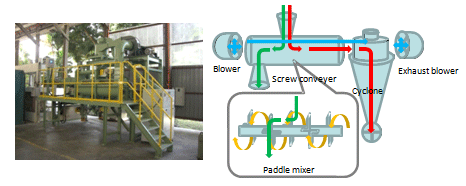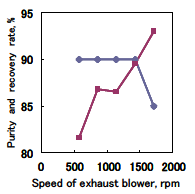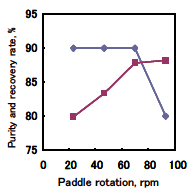Parenchyma-separator equipment for felled old oil palm trunks for efficient ethanol production
Description
The parenchyma of old oil palm trunks, which has accumulated starch, as well as the squeezed sap from oil palm trunks, are extremely promising as feedstocks for fuel ethanol production. For the advancement of efficient ethanol production, we have developed a new equipment which prepares the parenchyma tissues by utilizing the differences in density of the squeezed sap residues which are a mix of parenchyma and vascular bundles. We conducted a separation trial of the parenchyma using this equipment with cooperation from the Forest Research Institute Malaysia (FRIM). Then, we set out on the technology transfer or extension of fuel ethanol production technology from felled old oil palm trunks and its expansion locally.
We developed the parenchyma-separator equipment for efficient ethanol production from felled oil palm trunks. This system consists of a screw conveyor with paddle and separator with cyclone mode. A parenchyma-separator equipment is used in combination with an oil palm squeezing system that was developed previously.
This equipment consists of a screw conveyor and cyclone, and it separates the parenchyma, which accounts for approximately half of the total bulk, from the residues after the squeezing of the sap (Fig.1). Sap-squeezed residues which enter into slots of the separator are stirred in the screw conveyor, and the parenchyma bound to the vascular bundles is detached. Parenchyma with light specific gravity is aspirated by the exhaust blower, while vascular bundles with heavy specific gravity is transferred in the opposite direction of the air flow from the exhaust blower by a paddle mixer located in the screw conveyor, and then it is discharged from there (Fig.1 right, green arrow). Parenchyma aspirated by the exhaust blower is separated by means of a spiral air flow that spans around the cylinder of the cyclone. The isolated parenchyma is then collected from the rotary valve under the cylinder of the cyclone (Fig.1 right, red arrow). The quality of the parenchyma which is isolated from the cyclone is expressed as purity of the parenchyma fraction.
We changed the rotation frequency of the screw conveyor, paddle mixer, and the flow rate of the exhaust blower in order to optimize conditions for separation in this separator equipment. When the rotation of the screw conveyor or paddle mixer was 23 rpm or 70 rpm, respectively, the purity and collection of parenchyma fraction were increased until 1,420 rpm of the exhaust blower. However, the purity of parenchyma was decreased at over 1,700 rpm of the exhaust blower (Fig.2). We could obtain a parenchyma fraction with higher purity when the rotation of the paddle was up to 70 rpm, and when the rotation of the screw conveyor and exhaust blower was 23 rpm or 1,144 rpm, respectively (Fig. 3). Purity of parenchyma at ≧85%, and a collection yield of 80% of parenchyma were achievable with this system.
The moisture that was contained in the sap-squeezed residues has an effect on the purity and collection rate of the parenchyma. But this equipment is able to separate oil palm residues with different specific gravity by changing some operational parameters of this equipment (ex. rounds per minute of the screw conveyor and paddle mixer, and air flow rate from the exhaust blower).
Figure, table
-
Fig.1.
Picture (left) and diagram (right) of parenchyma-separator equipment for felled oil palm trunks. Red arrow: flow of parenchyma, Green arrow: flow of vascular bundles, Blue arrow: Direction of air flow, Yellow arrow: Rotation of paddle mixer. -
Fig.2.
Effect of exhaust blower on purity and recovery rate of recovery rate of parenchyma.
[[{"fid":"89321","view_mode":"wysiwyg","fields":{"format":"wysiwyg","field_file_image_alt_text[und][0][value]":false,"field_file_image_title_text[und][0][value]":false},"type":"media","field_deltas":{"8":{"format":"wysiwyg","field_file_image_alt_text[und][0][value]":false,"field_file_image_title_text[und][0][value]":false}},"attributes":{"class":"media-element file-wysiwyg","data-delta":"8"}}]] -
- Affiliation
-
Japan International Research Center for Agricultural Sciences Post-harvest Science and Technology Division
- Classification
-
Research B
- Term of research
-
FY2006~2010
- Responsible researcher
-
MURATA Yoshinori ( Post-harvest Science and Technology Division )
KOSUGI Akihiko ( Post-harvest Science and Technology Division )
ARAI Takamitsu ( Post-harvest Science and Technology Division )
MORI Yutaka ( Post-harvest Science and Technology Division )
FUJIMOTO Kiyohiko ( Forestry and Forest Products Research Institute )
YUSOFF Mohd Nor Mohd ( Forest Research Institute Malaysia )
IBRAHIM Wan Asma ( Forest Research Institute Malaysia )
ELHAM Puad ( Forest Research Institute Malaysia )
Sulaiman Othman ( Universiti Sains Malaysia )
Hashim Rokiah ( Universiti Sains Malaysia )
- ほか
- Publication, etc.
-
Mori, et al. (2010) Journal of the Japan Institute of Energy 89.12, 1147-1152.
Y. Murata et al. (2011) Development of a sap squeezing system from old oil palm trunks for the purpose of bioethanol production. 4th USM-JIRCAS Joint International Symposium.
- Japanese PDF



